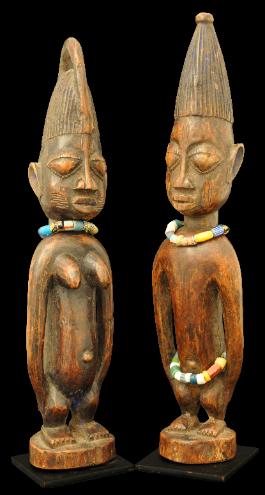
Yoruba Twins
Pair of Ibeji Twin Figures
Oyu-Yoruba People, Shaki, Nigeria
19th century
height: 29cm (male), 28cm (female), width: approximately 7cm each
Ere Ibeji
is a combination of Yoruba words: ere ‘sacred image’, ibi ‘born’ and eji ‘two’. These Ere Ibeji figures stand with their hands on their hips. Their facial features consist of bulging semi-rhombus eyes, fine long nose with flared nostrils and finely carved full lips. Eye lashes are finely carved around the eyes. Their eyelids are heavy, but they are not sleepy. They have large elongated ears and receding chins. Their eyes are not pierced, like most ibeji figures. Their facial expressions are serene, yet full of life.
The
Ere Ibeji figures supposedly represent infants. However, they are carved with mature features, such as the full pointy breasts, full bottoms, pubic hair and prominent genitals of both sexes. Their arms are long, and curved and extended from the neck and round shoulders. The male ibeji is standing with a protruding chest, whilst the female’s shoulders are slightly hunched forward. Both have elongated torsos and disproportionately short and slightly bent legs. Their feet are small and square, and incised with short toes. Each stands on a round socle, on top of a custom-made metal base.
Two vertical scarification lines (
pélé) are incised on both cheeks of the male ibeji figure. On the other hand, three horizontal scarification lines (àbàjà) are incised on the cheeks of the female ibeji figure. Both figures have two pélés incised on their foreheads.
The elongated head is a symbol of intelligence. According to the Yoruba beliefs, the head is where the spirit resides. The elongated head, accentuated by the vertically raised coiffure, symbolises one’s destiny and the height of one’s success.
The male
ibeji figure has a vertically raised single lobe coiffure. The dome of hair ends with a small round knob at the top. The female ibeji figure has a coiffure which is often associated with the wedding ritual.
Both
ibeji figures wear necklaces. These are composed of light blue, white and multi-coloured glass beads. The male ibeji figure has similar beads around his waist.
These
Ere Ibeji figures are in very good conditions and have excellent patina from age.
Yoruba people have the highest dizygotic (non-identical) twinning rate in the world. The births of twins amongst Yoruba women are four times more likely than anywhere else in the world. Unfortunately, the mortality rate of the twins also is very high.
Ere Ibeji figures were carved as spiritual representations of the twins who died. These figures were commissioned from village carvers, who were also often highly trained priests (Babalawo). They images were carved as adults, rather than as the deceased infants. It is common in African sculpture that child features in carving are more mature, including elaborate coiffures, scarifications on the face, fully developed breasts (on female figures), pubic hair and prominent genitalia. They were usually placed on a shrine dedicated to
Elegba (a divine messenger deity) in the living area of the house and fed, bathed and dressed regularly. These figures were particularly special to the mother, who kept them close to her and caressed the figures in a loving manner, hence the wear that genuinely old examples exhibit.References
Bacquart, J. B., The Tribal Arts of Africa, Thames & Hudson, 1998.
Finch, C., Finch & Co,
Autumn 2006 – Catalogue No. 9, Finch & Co., 2006.
Fagg, W. and J. Pemberton, J.,
Yoruba: Sculpture of West Africa, Collins, 1982.
Rowland, A., H.J. Drewal, and J. Pemberton,
Yoruba: Art and Aesthetics, Museum Rietberg, Zurich, 1991.
Provenance
private collection, UK
Inventory no.: 2358
SOLD


